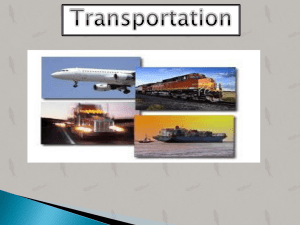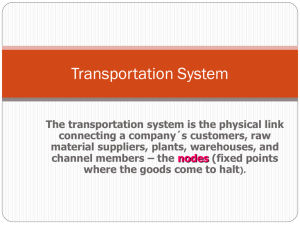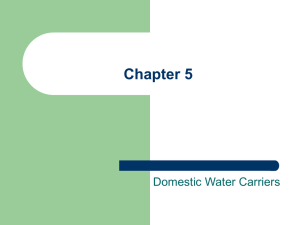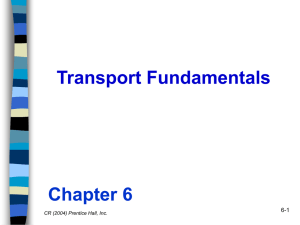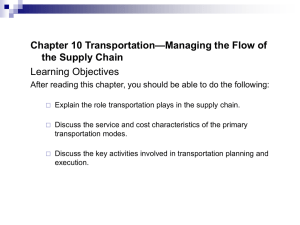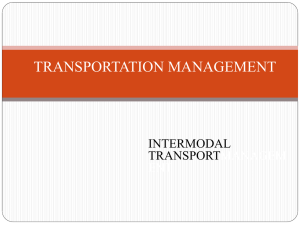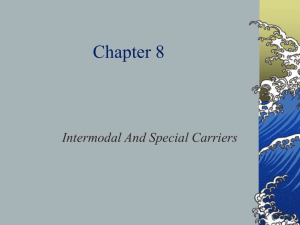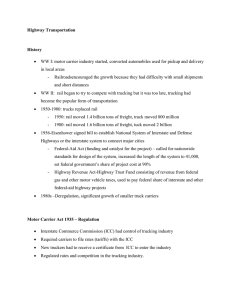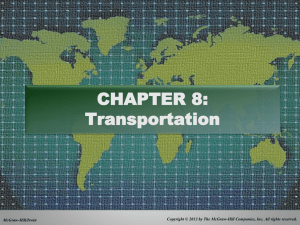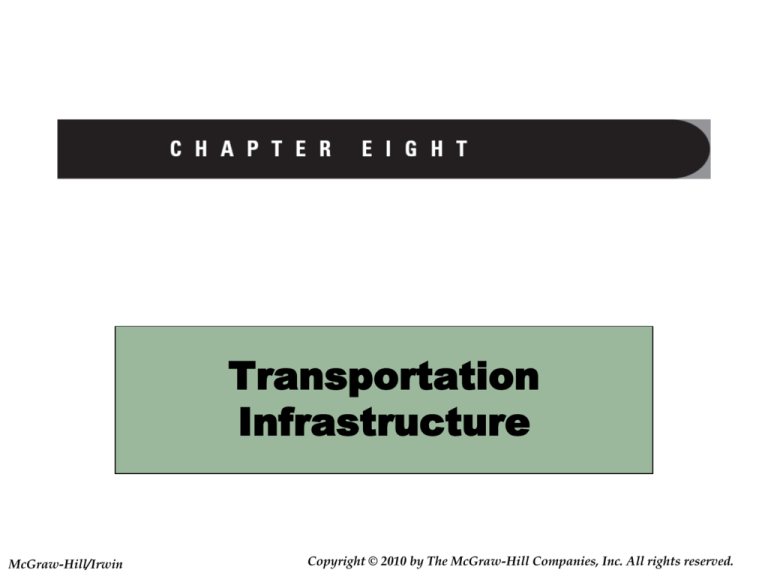
Transportation
Infrastructure
McGraw-Hill/Irwin
Copyright © 2010 by The McGraw-Hill Companies, Inc. All rights reserved.
Overview of transportation infrastructure
• Transport functionality, principles
and participants
• Transportation regulation
• Transportation structure
• Transportation service
8-2
Transportation infrastructure supports the
flow of our nations economy
Table 8.1 The Nations’ Freight Bill ($ billions)
8-3
Transport functionality primarily consists of
product movement services
• Product movement is the movement of inventory to
specified destinations
– Restrictive element—in-transit inventory is “captive”, usually
inaccessible during transportation
– Flexible element—inventory can be diverted during shipment to a
new destination
• Transportation consumes time, financial, and
environmental resources
– Transportation is more than 60% of the cost of logistics
– One of largest consumers of oil and gas in US
– Impacts traffic congestion, noise and air pollution
8-4
Transport also functions as storage services for
products while in a vehicle
• In-transit inventory is captive in the transport system
– Managers strive to reduce in-transit inventory to a minimum
• Product can also be stored in vehicles at origin or
destination (trailers, trucks, railcars, etc)
– Usually more expensive than traditional warehousing
• Must pay rental or demurrage charges on vehicles used for
storage
• Diversion occurs when a shipment destination is changed
after a product is in transit
8-5
Two fundamental transport principles
• Economy of scale is the cost per unit weight decreases as the size
of the shipment increases
– At least until you totally fill the carrying vehicle!
– Cost decreases because the fixed cost of the carrier is allocated over a larger
weight of shipment
• Economy of distance is the cost per unit weight decreases as
distance increases
– Often called the tapering principle
– Longer distances allow fixed cost of the carrier to be spread over more miles,
lowering the per mile charge
• Goal is to maximize the size of the load and distance shipped while
still meeting service expectations
8-6
Transport participants
•
•
•
•
•
•
Shipper
Consignee (Receiver)
Carrier and Agents
Government
Internet
Public
8-7
Major relationships among transportation
participants
Figure 8.1 Relationship Among Transportation Participants
8-8
Role and perspective of participants
• Shipper and consignee have a common interest in moving goods
from origin to destination within a given time at the lowest cost
• Carriers desire to maximize their revenue for movement while
minimizing associated costs
• Agents (brokers and freight forwarders) facilitate carrier and
customer matching
• Government desires a stable and efficient transportation
environment to support economic growth
• Public is concerned with transportation accessibility, expense, and
standards for security, safety and the environment
8-9
Role of the Internet in transportation
• The Internet now provides the vital communications links
between the transactional participants (shipper-carrierconsignee)
– Replacing phone and fax technologies
• Web-based enterprises provide information marketplaces
– Freight matching
– Fuel, equipment, parts and supplies purchases
8-10
Transportation regulation by the government
focuses on
• Economic regulation seeking to make transportation equally
accessible and economical to all without discrimination
– Government created infrastructure (roads, canals, ports)
– Intended to prevent carriers from taking advantage of suppliers while ensuring
long-term financial stability for carriers
• Social regulation which takes measures to protect public safety and
environment
– Department of Transportation (DOT) (1966) has active role in hazardous
material safety and driver safety
– Hazardous Materials Transportation Uniform Safety Act (1990) took
precedence over state and local regulations
8-11
History of transportation regulation
• In 1800’s, rise of steamships and railroads created immense wealth
and monopolies
– (e.g. Commodore Vanderbilt and the railroad “barons” )
• Interstate Commerce Commission (ICC) created in 1887 to oversee
regulation of interstate transportation
– To stop the railroad monopolies
• Other regulatory acts passed from 1906 to 1973 placed motor
carriers, shipping, air transport and pipeline transport under ICC
oversight
• By 1970, ICC had oversight on 100% of rail and air, 80% of pipeline,
43% of trucking and 6% of water carrier operations
8-12
Transportation deregulation (1980)
• Motor Carrier Act of 1980 deregulated the motor carrier industries
–
–
–
–
Entry restrictions for new businesses were relaxed
Restrictions for types of freight and range of services were abolished
Individual carriers were given the right to price their services
Trucking industry’s collective rate-making practices were abolished
• Staggers Rail Act of 1980 deregulated the rail industry
– Provide railroad management with freedom necessary to revitalize the industry
– Rail carriers were authorized to use selective pricing to meet competition and
cover operating costs
– Carriers given increased flexibility with respect to surcharges
– Contract rate agreements between individual shippers and carriers were
legalized
– Rail management given liberal authority to proceed with abandonment of
poorly performing rail service
8-13
Transportation regulation in the new millennium
is stimulated by technology and global issues
• Electronic Signatures in Global & National Commerce Act
of 2000
– Gave digital signatures legal status
• Patriot Act of 2001
– Increased inspections at ports, airport security, and increased
security at border crossings
• Continued Dumping and Subsidy Act
– Fines for artificial underpricing and “dumping” of foreign goods in
U.S. markets
• Jones Act
– Only U.S.-built ships operating under a U.S. flag with U.S. crews
can ship goods directly from a U.S. port to another U.S. port
8-14
Transportation structure
• Consists of rights-of-way,
vehicles, and carriers operating
within five basic modes
• A mode identifies basic
transportation method or form
–
–
–
–
–
Rail
Highway
Water
Pipeline
Air
8-15
Truck share of domestic freight market
exceeds all other modes combined
Table 8.2 Domestic Shipments by Mode and Volume
8-16
Rail mode has historically handled the largest
number of ton-miles within continental US
• Track mileage has declined by
over half since 1970
• Traffic shifted from broad range
of commodities to hauling
specific freight in traffic
segments
– Carload
– Intermodal
– Container
• New technologies include
articulated cars, unit trains and
double-stack cars
8-17
Truck mode has expanded rapidly since the end of
World War II
• Nearly 1 million miles of
highways in U.S.
• Key benefits include
– Speed of transit
– Ability to operate door-to-door
• More efficient than rail for small
shipments over short distances
• Dominate freight moves under
500 miles and from
manufacturing to wholesalers to
retailers
• Many companies run their own
truck fleets as well (e.g.
WalMart)
8-18
Water mode is the oldest form of US transport
dating back to the birth of our nation
• Percentage of ton-miles
has stayed between 19
and 30% since 1960’s
• Ranks between rail and
truck in fixed cost
• Right of way (canals and
rivers) maintained by
Federal government
8-19
Pipeline mode accounts for about 68 percent of all
crude and petroleum ton-mile movements in US
• Have the highest fixed cost
and lowest variable cost of
all modes
• Unique transportation
mode
– Can operate 24 hours a
day, 7 days a week
– No emissions
– No empty container or
vehicle to return
• Not flexible, and limited to
liquids and gases
8-20
Air mode is the newest and least utilized transport
mode for freight
• Accounts for only 1% of
intercity ton-miles
• Fastest of all the modes
• Fixed cost is 2nd lowest but
variable costs are
extremely high
• Most products air-shipped
have high value, high
priority or extreme
perishability
8-21
Comparison of fixed and variable cost
structure of each transport mode
Table 8.4 Cost Structure For Each Model
8-22
Operating characteristics used to classify
transport modes
• Speed is the elapsed movement time from origin to
destination
• Availability is ability of a mode to service any given pair of
locations
• Dependability is the potential variance from expected
delivery schedule
• Capability is the ability to handle any load size or
configuration
• Frequency is the quantity of scheduled movements a
mode can handle
8-23
Highway transport is appealing partly due to
its relative ranking across characteristics
Table 8.5 Relative Operating Characteristics by Mode
Lowest rank is best
Note: Lower is better
8-24
Infrastructure in crisis – US needs a National
Transportation Plan
• United States aggressively invested in highway construction after
World War II
– However, this highway system is in need of widespread repair to sustain the
safe movement of over 26 million trucks
• August 1, 2007 a major bridge span of interstate I-35 over the
Mississippi River collapses
– Watch video of aftermath by selecting this link (slideshow mode)
http://www.metacafe.com/watch/1659007/i_35_bridge_collapse/
• Roughly 12 percent (or 79,000) of public road bridges on the National
Bridge Inventory are classified as structurally deficient
8-25
Transportation service is achieved by
combining modes
• Traditional carriers are firms that provide service using only one of
the five basic transport modes
– E.g. trucking firm or an airline
• Package service uses intermodal transportation (ground and air) to
handle small shipments or parcel deliveries
– E.g. USPS, Fedex, or UPS
• Intermodal transportation combines two or more modes to take
advantage of the inherent economies of each and provide an
integrated service at a lower total cost
– E.g. piggyback service integrating rail and motor service
• Nonoperating intermediaries include several business types that
do not own or operate equipment
– Act to broker services by other firms
8-26
Package service provides both regular and
premium service
• Package service is growing rapidly with the rise in eCommerce and Internet consumer sales
• Ground package service offers regular delivery within
metropolitan areas and between cities
– United Parcel Service (UPS), Federal Express Ground and
United States Postal Service (USPS)
• Air package service is a premium service to deliver
certain packages door-to-door by next-day or second-day
– Integrates truck and air modes seamlessly
8-27
Piggyback is an intermodal transport that
integrates rail and motor service
• Most widely used systems are
– Trailer on a flatcar (TOFC)
– Container on a flatcar (COFC)
• Trailer or container is hauled by
truck at origin and destination
– Railcar hauls for portion of
intercity travel
• A variety of coordinated service
plans have been developed
8-28
Containerships are oldest form of intermodal
transport
•
•
Loads a truck trailer, railcar or
container onto barge or ship for the
line-haul movement on inland
waterways
Land bridge concept moves
containers in a combination of sea
and rail transport
– Common for containers moving from
Europe to Pacific Rim
•
Transfer of freight between modes
often requires handling containers
and imposition of duties
– Function of ports is to make this
seamless and fast
•
Port throughput is big concern for
supply chain managers
8-29
Coordinated air-truck is commonly used to
provide premium package services
• Many smaller cities lack
airfreight services
• Costs can leveraged with
delivery time by linking
the modes
8-30
Non-operating intermediaries do not own their
own equipment
•
•
Freight forwarders—businesses that
consolidate small shipments from
various customers into bulk shipment
for a common carrier for transport
Shipper associations and agents—
groups of shippers who employ an
agent to consolidate purchases and
shipments for them
– E.g. garment industry in New York
•
Brokers—intermediaries that
coordinate transportation
arrangements for shipper, consignees
and carriers, operating on a
commission basis
Sampling of Non-operating Intermediaries
8-31

